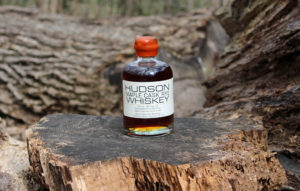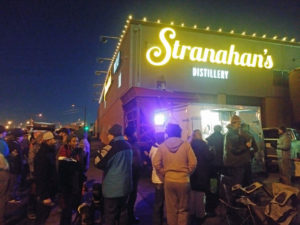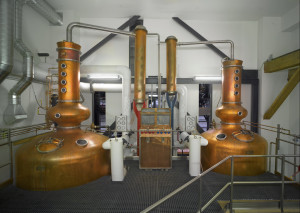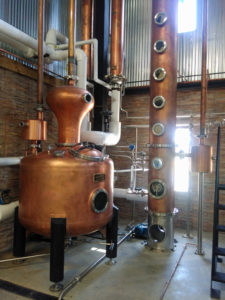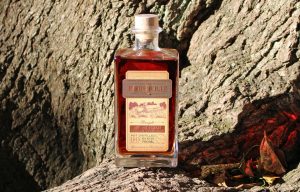By Richard Thomas
One of the idealized features of an artisanal movement–whether it be craft beer, craft whiskey or craft gin–is the spirit of independence. That ideal has existed more often in the imaginations of the imbibers than at the company making the booze, but it’s easy to understand how it got there: the little guy’s products are supposed to be the alternative to the stuff made by corporate giants. To some, that matters more than the relative quality of big versus small producers, and these are the folks who are inevitably horrified to discover their favorite craft brew is owned by Anheuser-Busch Inbev.
Truths like that leads many to look at their favorite local distillery, and wonder if it might not be absorbed into some international drinks conglomerate. As someone who has paid close attention to the craft whiskey scene for a decade and a half now, I say relax. The big boys are interested only in the oldest, best established and most widely distributed of the craft brands, as the following timeline and list demonstrates. I’ve excluded cases where the big company bought only a minority share in the small distiller, as those are really investments rather than acquisitions. Also excluded are the acquisitions of brands that cannot really be considered small or craft, like the purchases of Bardstown Bourbon Company, Rabbit Hole and Luxco.
2010:
Stranahan’s was one of the forerunners of craft whiskey, selling their first bottle in 2006 and opening the way for Colorado’s vibrant small distilling scene. This was just six years after St. George’s Spirits introduced their first single malt, so Stranahan’s was also one of the cornerstones in what is now the American Single Malt category. They were bought by Proximo in 2010. It was also one of the first major acquisitions of a craft distiller by a major drinks firm.
The other major acquisition that year was the first stage of William Grant & Sons acquiring Hudson Whiskey. In an unusual move that hasn’t been duplicated since, the makers of Glenfiddich bought the brand made by Tuthilltown Distillery in 2010, but didn’t acquire the actual distillery until 2017. Like Stranahan’s, Tuthilltown was a trailblazer in American small distilling, part of a lobbying effort to rewrite New York State laws to make them more friendly to such enterprises.
2016:
Utah’s High West helped blaze the trail that many have followed since: build your brand with sourced whiskeys, then build your distillery. A decade ago, their transparent approach to their sourcing won them much applause from purists. They were acquired by Constellation Brands for an estimated $160 million.
2017:
Although Washington’s Westland Distillery insists they are not a “craft” distiller, they aren’t a major spirits-maker either. They were acquired by Remy-Cointreau in early 2017.
Another Washington State whiskey buy-out that year saw Woodinville Whiskey acquired by Moet Hennessy. Woodinville gained much acclaim in the early-to-middle craft whiskey picture for building their brand around whiskeys aged for five years. That has become more of a normal thing in the years since, as more craft distillers have introduced bottled in bond whiskeys, but that was a novelty when Moet Hennessy bought them.
Much like High West, West Virginia’s Smooth Ambler started out by sourcing whiskeys to build their brand, then built their distillery and began work on their in-house spirits. French drinks giant Pernod Ricard bought a majority stake in the company at around the same time as Remy-Cointreau closed the deal on Westland Distillery.
2019:
Nelson’s Greenbrier, a revived family-owned and -operated legacy distillery, produces the only wheated Tennessee Whiskey available today. Constellation Brands acquired a majority stake in the company in 2019.
Firestone & Robertson launched in 2012 with their sourced TX Blended Whiskey, and built an impressive, visitor-friendly Whiskey Ranch as their distillery on the outskirts of Dallas-Fort Worth. Pernod Ricard bought them.
2022:
This deal operated like a Russian nesting doll. Samson & Surrey is basically a craft spirits holding company, and in the whiskey department they bought up FEW Spirits, Widow Jane and Brenne. The company was acquired in its turn by Heaven Hill in February 2022.
In October 2022, Campari expanded its holdings in Kentucky by buying a 70% stake a distiller started by a pair of veteran industry insiders, Wilderness Trail, for $420 million. Campari was already the owner of Wild Turkey.
A few days after Campari bought Wilderness Trail, the world’s biggest drinks conglomerate, Diageo, bought the Texas whiskey distillery Balcones.
Colorado’s Breckenridge Distillery, billed as the world’s highest, was bought by a Canadian cannabis company.
Finally, there last year saw the rare instance of one small distilling firm acquiring another, when Pennsylvania’s Millstone Spirits Group (i.e. New Liberty Distillery) bought Faber Distilling. Faber doesn’t make whiskey, but New Liberty does, and the rarity of this kind of move makes it noteworthy.
Bucking the overall trend was Old Potrero. When Japanese drinks company Sapporo bought Anchor Brewing and Distilling in 2018, the deal did not include Old Potrero, which was spun off into a new company called Hotaling & Co. Old Potrero was part of a class of small distillers that predated the craft movement as we know it today, having been founded before the middle 2000s.
When looking at this long string of buy-outs going back more than a decade, the first question to ask yourself is if there is really any call to worry about a buy-out. Most readers probably never tried either Hudson Whiskey or Stranahan’s before 2010, but I can tell you both brands have improved markedly over time, and the details of their production process evolution bear that opinion out in objective terms. The most famous example of a buy-out clearly improving things was Kirin’s acquisition of Four Roses, which brought the brand back from being neglected rotgut into a bourbon celebrated by a devoted fan base. Generally speaking, its the entertainment industry that sees big companies strangling the goose that lays the golden egg; in drinks, that doesn’t often happen.
But if you are still worried that your favorite local craft distillery might get bought up, the flurry of activity in 2022 looks to have petered out. The only notable whiskey purchase so far in 2023 was Barrell Craft Spirits buying a rickhouse in Shively for $2.4 million, which is really just an infrastructure expansion for the admired negociant. Beyond that, the trend is pretty clear: a major company would only be interested in buying your local distiller, with that cool cocktail bar and tasting room you enjoy so much, if it has been around for more than a decade and is a nationally recognized brand with distribution to match.
Otherwise, bankruptcy and asset stripping is the thing you should really be afraid of. In researching this article, I discovered that a small whiskey-maker that I incorporated into the new edition of my American Whiskey, Savannah’s Ghost Coast Distillery, closed its doors in September. So think on that when you decide where to go out for a drink this weekend.
 The Whiskey Reviewer A World of Whiskey, Poured Every Weekday
The Whiskey Reviewer A World of Whiskey, Poured Every Weekday
